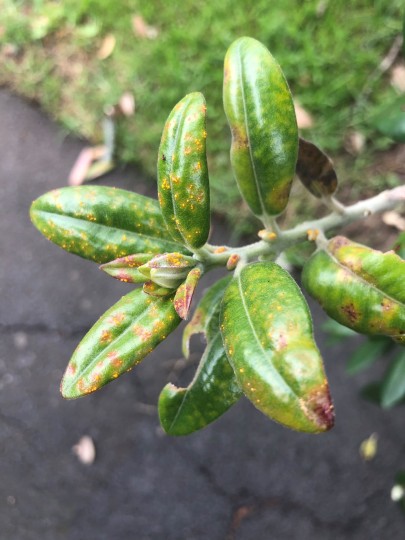Summer 2022/23 iNaturalist report: fewer myrtle rust observations than expected
Between 1 November 2022 and 10 June 2023, 893 new observations of myrtle rust (or rather Austropuccinia psidii, the fungus that causes myrtle rust) were reported in New Zealand. This is only slightly more observations than were reported last year during the same window (827 between 1 November 2021 and 10 June 2022) but still substantially more than the 561 observations between 1 November 2020 and 10 June 2021.
Some of these observations reported infections on the most vulnerable hosts we have in New Zealand: cultivated lillypilly hedge plants, Lophomyrtus species (ramarama and rōhutu as well as hybrids of these two species and cultivars) and swamp maire. However, there appear to be more reports coming in of infections on less susceptible hosts, including cultivated bottle brush and climbing rātā, both in gardens and in the bush.
 As reported in a press release earlier this year, there were significantly more observations of infected pōhutukawa than in previous seasons. Over the 2021/22 summer, there were about 55 observations of myrtle rust on pōhutukawa. But in the 2022/23 summer, there were about 400 reports, which supported anecdotal evidence that pōhutukawa was harder hit this year than in previous years.
As reported in a press release earlier this year, there were significantly more observations of infected pōhutukawa than in previous seasons. Over the 2021/22 summer, there were about 55 observations of myrtle rust on pōhutukawa. But in the 2022/23 summer, there were about 400 reports, which supported anecdotal evidence that pōhutukawa was harder hit this year than in previous years.
If there were so many more reports for pōhutukawa and for other less susceptible plants, then why weren’t there more overall observations? Based on the jump from 561 observations from the 2020/21 summer to the 827 observations in the 2021/2022 summer, why wasn’t a similar jump observed this year?
Human behaviour is likely playing a role.
“I don’t post a picture every time I see myrtle rust to be honest,” says Peter de Lange, avid iNaturalist user. “It would be heartbreaking in Auckland. But if it’s a new host plant for the disease or a new host for the region, I add my observation. For example, on the Chatham Islands, I’ve got the first record of it on pōhutukawa there now. I added this observation because I thought it would be useful information to share.”
Another reason for the fewer-than-expected observations is that usually an observation is only reported once. If an observer already reported an infection on lillypilly or ramarama last season for example, they wouldn’t report that infection on the same plant the following season. This could be leading to fewer observations being made for more vulnerable hosts. In the particular case of myrtle rust, it is hoped that people will include repeat observation, as these may help with monitoring current levels of disease.
There is some hope that the upcoming summer will give our Myrtaceae a reprieve from infection. Austropuccinia psidii thrives in warm, humid conditions. If this summer ends up being as dry and hot as it is expected to be, myrtle rust may slow down.
If you would like to contribute your observations of myrtle rust, you can do so on the iNaturalist NZ website or app. Please name the host plant in the notes section if you know it. If you’re not sure how to identify susceptible plants, i.e., plants in the Myrtaceae family, check out this Myrtaceae Key. The myrtle rust community is especially interested in reports on Metrosideros albiflora, whose infection status is currently unknown.
- Jenny Leonard
